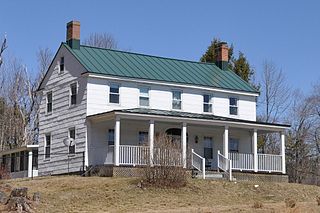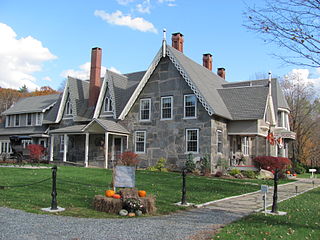
The Benjamin Cleaves House is a historic house on South High Street in Bridgton, Maine, United States. Built in 1828, it is a well-preserved late example of Federal period architecture, and is most notable for the murals drawn on its walls, probably by the itinerant artist Rufus Porter. The house was listed on the National Register of Historic Places in 1988.

Cushman Tavern was an historic tavern at Maine State Route 9 and Webster Corner Road in Sabattus and Lisbon, Maine. Built c. 1825, this Federal period house was most significant for the folk artwork drawn on the walls of its halls and stairwell by Orison Wood, an itinerant muralist and protégé of Rufus Porter, a well-known exponent of the form. The house was listed on the National Register of Historic Places in 1979. It was demolished in 2019 after standing vacant and deteriorating for several years, and was delisted in 2020.

The Union Meeting House is a historic church at 2614 Burke Hollow Road in Burke, Vermont. Completed in 1826 as a worship space for four congregations, it is a well-preserved example of vernacular Federal architecture. It was listed on the National Register of Historic Places in 2008.

The Emerson–Franklin Poole House is a historic house at 23 Salem Street in Wakefield, Massachusetts. Built about 1795, it was in the 19th century home to Franklin Poole, a locally prominent landscape artist. Some of its walls are adorned with the murals drawn by Rufus Porter. The house was listed on the National Register of Historic Places in 1989.

The Kate Douglas Wiggin House, also known as Quillcote, is a historic house on Salmon Falls Road in Hollis, Maine. Built in 1797, the house is significant as the home of the writer Kate Douglas Wiggin from 1905 until her death in 1923, and as a fine example of adaptive architectural change over time. One room of the house features wall murals attributed to Rufus Porter. The house was listed on the National Register of Historic Places in 1977.

The Deacon Hutchins House is an historic house on Maine State Route 5 in Rumford, Maine. Built c. 1802, it is an excellent example of vernacular Federal style architecture, and is further notable for murals drawn in one room by the itinerant painter Rufus Porter. It was listed on the National Register of Historic Places in 1987.

The Moses Kent House is a historic house on River Road in Lyme, New Hampshire. Built in 1811, it is a good local example of Federal period architecture, most notable for the well-preserved murals on its interior walls, drawn by the itinerant artist Rufus Porter. The house was listed on the National Register of Historic Places in 1984.

The Capt. Samuel Allison House is a historic house on New Hampshire Route 101, overlooking Howe Reservoir, in Dublin, New Hampshire. Built about 1825 by a locally prominent mill owner, it is a good local example of Federal style residential architecture. The house was listed on the National Register of Historic Places in 1983.

The Daniel Carr House is a historic house on Brier Hill Road in Haverhill, New Hampshire. Built about 1796, the house is most notable for the high quality folk murals drawn on its walls, most likely by the itinerant artist Rufus Porter between 1825 and 1830. The house was listed on the National Register of Historic Places in 1992.

The Barrows-Steadman Homestead is a historic house at the northeast corner of Main and Stuart Streets in Fryeburg, Maine, United States. Built c. 1809, this frame house is a good vernacular example of Federal architecture, but is most notable for the murals painted on the walls of one of its bedrooms by Rufus Porter and Jonathan Poor, noted itinerant painters of the 19th century. The house was listed on the National Register of Historic Places in 1982.

The Enoch Hall House is a historic house on Bean Road in Buckfield, Maine. Probably built in the 1790s, this house is notable as the home of one of Buckfield's early settlers, Enoch Hall, a politically active man who helped draft the Maine State Constitution in 1819. The house is also notable for the murals drawn on the walls of the second floor hallway and bedrooms probably around 1830; the artist is unknown. The house was listed on the National Register of Historic Places in 1993.

The Dr. Moses Mason House is a historic house museum at the northeast corner of Broad Street and Mason Street in Bethel, Maine. Built c. 1813–15, it is notable as the home of one of Bethel's early doctors and first postmaster, Moses Mason (1789-1866), and for the murals drawn on some of its walls by the itinerant artist Rufus Porter. The building was listed on the National Register of Historic Places in 1972; it is now owned by the Museums of the Bethel Historical Society, and is open year-round for tours.
The Burgess House is a historic house on Burgess Road, just east of Austin Road in Sebec, Maine, United States. The oldest portion of this wood-frame house dates to about 1816, and was built by Ichabod Young, who erected the first fulling mill in Piscataquis County. The house is most remarkable for its high-quality interior woodwork, and for the artwork on the walls of several of its rooms, which includes paintings by Rufus Porter and stencilwork by Moses Eaton, Jr., two noted itinerant artists of the early-to-mid 19th century. The house was listed on the National Register of Historic Places in 1978.

The McCleary Farm is a historic farm complex on South Strong Road in Strong, Maine. Probably built sometime between 1825 and 1828, the main house is a fine local example of Federal style architecture. It is most notable, however, for the murals drawn on its walls by Jonathan Poor, an itinerant artist active in Maine in the 1830s. The property was listed on the National Register of Historic Places in 1989.

The Benjamin and Abigail Dalton House is a historic house on Middle Road in North Parsonsfield, Maine. Built in the early 19th century, it is a fine local example of Federal style, and is notable for the murals drawn on its walls by Jonathan Poor, an itinerant artist. The house was listed on the National Register of Historic Places in 1997.

The Capt. James Morison House is a historic house on South Road in Parsonsfield, Maine. Built about 1785 by a veteran of the American Revolutionary War, it is a well-preserved example of early Federal architecture, and is further noted for the murals painted by the itinerant artist Jonathan D. Poor on its walls. It was listed on the National Register of Historic Places in 1978.

Glimmerstone is a historic mansion house on Vermont Route 131, west of the village center of Cavendish, Vermont. Built 1844–47, it is a distinctive example of Gothic Revival architecture, built using a regional construction style called "snecked ashlar" out of locally quarried stone flecked with mica. The house was listed on the National Register of Historic Places in 1978.

The Stagecoach Inn is a historic building at the corner of United States Route 7 and Fern Lake Road in the center of Leicester, Vermont. Built about 1830, it is one of the best-preserved examples of a 19th-century stagecoach accommodation between Rutland and Vergennes, with a distinctive combination of Federal and Greek Revival architectural elements. Now converted to a residence, it was listed on the National Register of Historic Places in 1984.

The John Wilder House is a historic house on Lawrence Hill Road in the village center of Weston, Vermont. Built in 1827 for a prominent local politician, it is a distinctive example of transitional Federal-Greek Revival architecture in brick. Some of its interior walls are adorned with stencilwork attributed to Moses Eaton. The house was listed on the National Register of Historic Places in 1983.

The Follett House is a historic house at 63 College Street in Burlington, Vermont. Built in 1840 for a prominent local businessman, it is the last surviving grand 19th-century lakeside mansion in the city, and one of the state's finest examples of Greek Revival architecture. It was listed on the National Register of Historic Places in 1972. It has seen commercial and institutional uses since 1885.






















